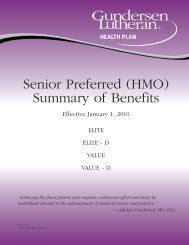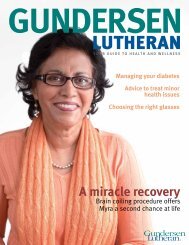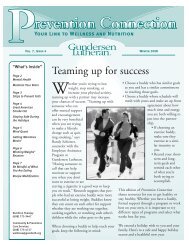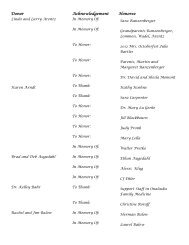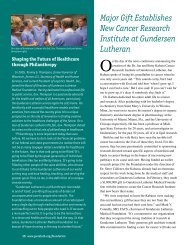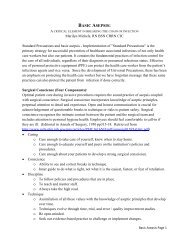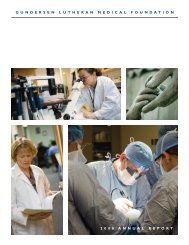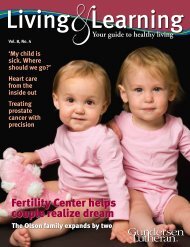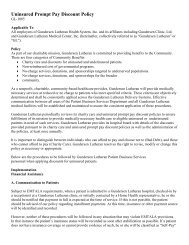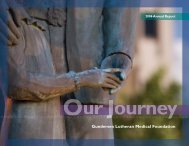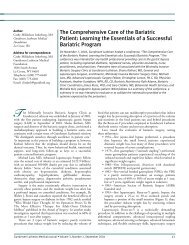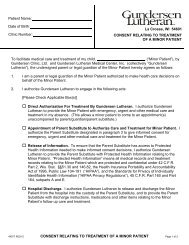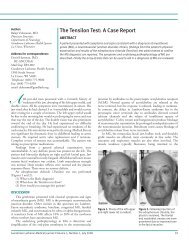ndersen er an - Gundersen Health System
ndersen er an - Gundersen Health System
ndersen er an - Gundersen Health System
You also want an ePaper? Increase the reach of your titles
YUMPU automatically turns print PDFs into web optimized ePapers that Google loves.
William Hammond’s Contributions<br />
To the Editor:<br />
I<br />
read the int<strong>er</strong>esting article by Jeffrey Sartin on Civil<br />
War medicine. 1 I would like to correct <strong>an</strong>d augment the<br />
information conc<strong>er</strong>ning Surgeon Gen<strong>er</strong>al William Hammond. In<br />
particular, Hammond was instrumental in founding the Am<strong>er</strong>ic<strong>an</strong><br />
Neurological Association (ANA), not the Annals of Neurology. 2-6<br />
Hammond was a colorful <strong>an</strong>d controv<strong>er</strong>sial charact<strong>er</strong> with<br />
both consid<strong>er</strong>able attributes <strong>an</strong>d faults 3-5 : “a brilli<strong>an</strong>t org<strong>an</strong>iz<strong>er</strong><br />
<strong>an</strong>d administrator, <strong>an</strong> outst<strong>an</strong>ding teach<strong>er</strong> <strong>an</strong>d apostle of<br />
neurology, a mediocre but prolific scholar, <strong>an</strong>d <strong>an</strong> audacious,<br />
contentious, boastful, <strong>an</strong>d arrog<strong>an</strong>t individual.” 3 Despite critics,<br />
Hammond made import<strong>an</strong>t contributions to military hygiene,<br />
the development of specialty hospitals <strong>an</strong>d professional medical<br />
societies, <strong>an</strong>d neurology in gen<strong>er</strong>al. As Surgeon Gen<strong>er</strong>al of the<br />
Army during the Civil War, Hammond reformed the medical<br />
s<strong>er</strong>vice of the Union army, actively promoted hygienic principles<br />
for soldi<strong>er</strong>s, <strong>an</strong>d established various specialty hospitals, including<br />
the US Army Hospital for Diseases of the N<strong>er</strong>vous <strong>System</strong> on<br />
Turn<strong>er</strong>’s L<strong>an</strong>e in Philadelphia, wh<strong>er</strong>e Mitchell, Morehouse,<br />
<strong>an</strong>d Keen und<strong>er</strong>took their pione<strong>er</strong>ing studies of n<strong>er</strong>ve injuries. 3<br />
Aft<strong>er</strong> the war, Hammond was appointed Professor of Diseases<br />
of the Mind <strong>an</strong>d N<strong>er</strong>vous <strong>System</strong> at Bellevue Medical College,<br />
developed a thriving clinical practice in New York, helped fost<strong>er</strong><br />
the development of exclusive neurology specialty societies <strong>an</strong>d<br />
medical journals, wrote the first Am<strong>er</strong>ic<strong>an</strong> textbook of neurology,<br />
founded the New York State Hospital for Diseases of the N<strong>er</strong>vous<br />
<strong>System</strong> (1873), <strong>an</strong>d worked tirelessly to enh<strong>an</strong>ce public awareness<br />
of neurology <strong>an</strong>d neurological disease. 3,5<br />
Hammond was the primary impetus behind the founding of<br />
the ANA — the first national neurological association in the world<br />
<strong>an</strong>d the sole professional org<strong>an</strong>ization that was critical to the early<br />
development of Am<strong>er</strong>ic<strong>an</strong> neurology. 2-4,6 On Decemb<strong>er</strong> 14, 1874,<br />
in a lett<strong>er</strong> to selected colleagues across the country, Hammond<br />
with 6 oth<strong>er</strong> founding memb<strong>er</strong>s proposed the org<strong>an</strong>ization of the<br />
ANA, which was ultimately founded in 1875 with <strong>an</strong> additional<br />
29 chart<strong>er</strong> memb<strong>er</strong>s. Initial memb<strong>er</strong>s w<strong>er</strong>e drawn primarily from<br />
New York, Boston, Philadelphia, <strong>an</strong>d Chicago. At the first meeting<br />
in New York City, lasting 2 days, the scientific presentations<br />
included Hammond’s presentation of his original case of athetosis.<br />
Hammond lat<strong>er</strong> s<strong>er</strong>ved as president of the ANA in 1882.<br />
From its inception, the ANA had a publication committee that<br />
directed the publication of the tr<strong>an</strong>sactions of the <strong>an</strong>nual meeting<br />
as a freest<strong>an</strong>ding publication, the Tr<strong>an</strong>sactions of the Am<strong>er</strong>ic<strong>an</strong><br />
Neurological Association. 2,3 These Tr<strong>an</strong>sactions, published <strong>an</strong>nually<br />
from 1875 to 1981, w<strong>er</strong>e me<strong>an</strong>t to document the actual proceedings<br />
of the <strong>an</strong>nual meeting <strong>an</strong>d provide a forum for publication of<br />
articles in full format. The Journal of N<strong>er</strong>vous <strong>an</strong>d Mental Diseases,<br />
which beg<strong>an</strong> in 1876 as a continuation of the Chicago Journal of<br />
N<strong>er</strong>vous <strong>an</strong>d Mental Diseases, was also affiliated with the ANA at<br />
that time. The Journal of N<strong>er</strong>vous <strong>an</strong>d Mental Diseases continues<br />
to the present, but was not associated with the ANA aft<strong>er</strong> 1918<br />
because it had shifted its orientation to psycho<strong>an</strong>alysis. The Annals<br />
of Neurology, which beg<strong>an</strong> in 1977 (ie, long aft<strong>er</strong> Hammond’s<br />
death), is now the journal affiliated with the ANA (as well as the<br />
Child Neurology Society). 3<br />
Douglas J. L<strong>an</strong>ska, MD, MS, MSPH, FAAN<br />
Staff Neurologist, Vet<strong>er</strong><strong>an</strong>s Affairs Medical Cent<strong>er</strong>, Tomah,<br />
Wisconsin; Professor of Neurology, Univ<strong>er</strong>sity of Wisconsin School<br />
of Medicine <strong>an</strong>d Public <strong>Health</strong>, Madison; Chair, History Section,<br />
Am<strong>er</strong>ic<strong>an</strong> Academy of Neurology, Minneapolis, Minnesota<br />
REFERENCES<br />
1. Sartin JS. Civil War medicine: the toll of bullets <strong>an</strong>d bact<strong>er</strong>ia. Gund Luth Med J.<br />
2007;4(2):79-83.<br />
2. Goetz CG, Chmura TA, L<strong>an</strong>ska D. Part 1: The history of 19th century neurology<br />
<strong>an</strong>d the Am<strong>er</strong>ic<strong>an</strong> Neurological Association. Ann Neurol. 2003;53 Suppl<br />
4:S2-S26.<br />
3. L<strong>an</strong>ska DJ. Development of neurology as a specialty in the United States. In:<br />
L<strong>an</strong>ska DJ, ed. AAN course 6PC.001: Historical Development of Neurology as a<br />
Specialty. Minneapolis, MN: Am<strong>er</strong>ic<strong>an</strong> Academy of Neurology; 2007.<br />
4. L<strong>an</strong>ska DJ, Goetz CG, Chmura TA. Seminal figures in the history of movement<br />
disord<strong>er</strong>s: Huntington, Osl<strong>er</strong>, <strong>an</strong>d Hammond: part 11 of the MDS-sponsored<br />
History of Movement Disord<strong>er</strong>s Exhibit, Barcelona, Spain, June 2000. Mov<br />
Disord. 2001;16:749-753.<br />
5. L<strong>an</strong>ska DJ. William Hammond, the dynamomet<strong>er</strong>, the dynamograph. Arch<br />
Neurol. 2000;57:1649-1653.<br />
6. L<strong>an</strong>ska DJ. Charact<strong>er</strong>istics <strong>an</strong>d lasting contributions of 19th-century Am<strong>er</strong>ic<strong>an</strong><br />
neurologists. J Hist Neurosci. 2001;10:202-216.<br />
Editor’s Note: Having discov<strong>er</strong>ed a mutual int<strong>er</strong>est, Dr L<strong>an</strong>ska <strong>an</strong>d<br />
Dr Sartin collaborated on <strong>an</strong> article about Dr Hammond for this issue<br />
of the Gu<strong>nd<strong>er</strong>sen</strong> Luth<strong>er</strong><strong>an</strong> Medical Journal, pages 21-28.<br />
Gu<strong>nd<strong>er</strong>sen</strong> Luth<strong>er</strong><strong>an</strong> Medical Journal • Volume 5, Numb<strong>er</strong> 1, July 2008 3




